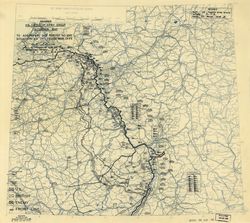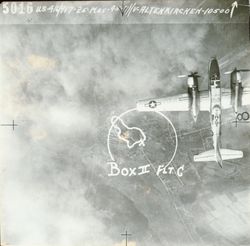 |
Lou Prucha WWII Service
|
 |
Altenkirchen, Germany
(Road Junction)

Pilot's Flight Log |

12th Army Group Situation Map 25-Mar-1945 |
piloting 668 Bomb Sq. A-26B-20-DL Invader, Serial # 41-39274, Fuselage code 5H-S.
Click to display the official 416th Bomb Group Mission Folder, Mission Report and Operational Report
scanned to PDF files by the Air Force Historical Research Agency (AFHRA).
Photo from the collection of 416th BG Aerial Photo Officer Captain Francis J. Cachat. Carl Sgamboti initially published nearly 800 of these photos on his 416th Bombardment Group (L) Photo Gallery web pages. An expanded set is available on Wayne Sayles' 416th BG website Captain Francis J. Cachat's 416th Photo Collection page.
Group, Unit and Historical Extracts for Mission 253
"416th Bombardment Group (L) - Group History 1945"
Transcribed from USAF Archives
For the fifth day running, on the 25th, two missions were flown. The morning mission was a full scale attack on the road junctions at Altenkirchen. Buildings in the northwestern and central part of the town were destroyed. Buildings were left burning in five separate places. Road traffic was blocked by debris and craters. Crossing the bomb line, some weak inaccurate flak was fired at the formation. As it approached the target on the bomb run, it experienced moderate accurate flak. Twenty-two planes suffered battle damage; seven of them were category "AC". Lt. Barausky's plane was hit in the right engine on the bomb run and it was knocked out. He feathered his prop, continued on to the target, and dropped his bombs. He got a heading back to Y-57 and prepared to crash land. His B-N, Lt Sheehan, came back in the cockpit to brace himself. The right strut had been shot up and the right tire shot out. He chose the dirt portion of the field for his landing. He feathered his left engine (his right was already feathered). Both the gunner and the bombardier jettisoned their hatches, so that they could get out of the plane quickly. The left engine was torn off as the plane sank into the grass. The gunner, Sergeant Hall, was slightly injured. Captain Miller, Lts. Connor and Johnson, B&N, and Captain Stebbins, Lt. Calloway, B-N, were the box leaders.
"Attack Bombers, We Need You! A History of the 416th Bomb Group"
Ralph Conte
Pages 240 - 241
Mission #253 -25 March - AM - Altenkirchen Communication Center. Forty-eight planes were sent to demolish this road junction. Captain Miller with Lts. Conner and Johnson, BNs were leading Box I. Captain Stebbins and Lt. Calloway BN led Box II. Lts. Buskirk and Hanna BN,- Captain Sutton and Lt. Reed BN, and Lt. Fero with F/O Langsom BN headed up flights. The planes met varying degrees of flak on the bomb line into the target, causing 22 ships damaged. Bombing results were excellent for some flights. A few flights could not be assessed. Lt. Barausky took a direct hit on the right engine. A large part of the nacelle fell off. He feathered the prop but continued on the bomb run. He headed for field Y-57 after dropping his bombs, to make a crash landing. His BN Lt. Sheehan came back from the nose of the ship and sat on the shot gun position for safety during the crash landing. Going in, Barausky feathered his left engine, gliding in. The gunner and the BN jettisoned their hatches, preparatory to a quick get out on landing. The left engine tore loose from its mounting, but all got out of the plane after it sank into the mud off the runway. Gunner Sgt. Ball was slightly injured.
"History of 670th Bombardment Squadron (L)"
Transcription from USAF Archives
The Altenkirch Communications Center was attacked on the 25th of March, and what remained of the town was destroyed. Over the target Lt. Barauskyís aircraft was badly hit in the right engine. A large part of the engine nacelle was knocked off, but he feathered the propeller and peeled off the bomb run with gas and oil leaking badly. He closed his bomb bay doors and headed towards the bomb line on single engine. A portion of his right nacelle was bent upwards, causing a great degree of drag, thus the normally good single engine performance of the aircraft was hampered. When he got in the vicinity of Trier, Germany, he had to crash land at the Trier airport. Just before he hit he feathered the remaining engine and made a no-engine landing. Although the aircraft was completely washed out, neither Lt. Barausky, his bombardier/navigator, nor his gunner were injured.
"671st Bomb Squadron (L) Unit History"
Gordon Russell and Jim Kerns
General Andersonís forces shifted the attack to the central sector of the Western Front in a new aerial offensive with the main weight directed against marshalling yards on the main lines out of Frankfurt and communication centers east of the Ramagen bridgehead. For the fifth straight day the 416th Bomb Group chalked up two missions.
Forty-eight aircraft were dispatched in the morning against Altenkirchen east of Ramagen. The bombers met varying degrees of flak in and around the target and 22 of the ships received battle damage. One ship made a crash landing near Trier, but the crew reported safe. Results ranged from undetermined to excellent. Photos were not available on a number of flights because of evasive action off the target. Crews reported the bombs hitting in the town however.
Crystal-clear skies over the Fulda Marshalling Yard enabled the 416th bombardiers to score two superiors and four excellents as the bombers covered the yard with thousand pound eggs. Lt. Lackovich and Lt. Muir chalked up one of the two superiors. The bombs from their flight blanketed the railroad tracks with the center of the burst just 100 feet from the DMPI. Twenty goods wagons were damaged or destroyed and an overpass was hit.
All in all, the six flights just about wiped out the yard and its contents. There were no loses, casualties or battle damage.
"USAAF Chronology of WWII, month by month"
TACTICAL OPERATIONS (Ninth Air Force): In Germany, the 9th Bombardment Division hits 4 communications centers, 3 marshalling yards, and targets of opportunity, including flak positions; fighters fly escort, armed reconnaissance, and missions against several ground targets; fighters support the US 79th Infantry Division as it pushes 2 miles (3.2 km) to the E of the Rhine River (SE of Wesel), the III and VII Corps as they begin their breakout assault toward Altenkirchen and in the Epgert and Willroth areas, and the XII Corps as it establishes bridgeheads on the Main River in the Hanau and Aschaffenburg areas.
